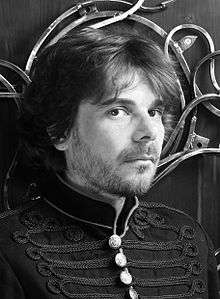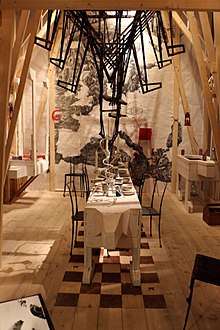Duilio Forte
Duilio Forte (5 November 1967) is an Italian artist and architect.
Duilio Forte | |
|---|---|
 Forte in 2010 | |
| Born | 5 November 1967 (age 52) Milano, Italy |
| Nationality | Italian |
| Occupation | Architect |
Biography
He graduates in architecture in 1994 at the Politecnico di Milano. That same year he wins the first prize of San Carlo Borromeo at La Permanente of Milan, under the jury of Achille Castiglioni and Giancarlo De Carlo, with the Ekeberg sauna made in Sweden.
He founds Atelier Forte in 1998, an architecture and sculpture research laboratory that deals with the design and creation of artistic and architectural works.[1]
Every year since 2003, he has been organizing a workshop of art and architecture in Sweden called StugaProject, near the town of Grythyttan.
He has been a member of the Swedish Association of Architects since 2005.
He participates in the 11th International Architecture Exhibition of Venice (2008) with Sleipnir Venexia.[2]
It was on 12 February 2009, for the 200th anniversary of Darwin's birth, that Duilio Forte wrote the Arkizoic Manifesto, the architectural style characterized by the union between architecture and Anemos, the breath of life.
He participates in the 12th International Architecture Exhibition of Venice (2010) with Sleipnir Convivalis.[3][4]
He participates to the XXI Triennale International Exhibition of Milan in 2016 with the work URSUS at the exhibition Rooms, curator Beppe Finessi.
- "His whole life is a workshop. He is the veritable "Craftsman" of the Italian architecture, both designer and builder. He doesn't need to talk to the workers or constantly see what they are doing. He does everything himself. His pencil is a saw, his AutoCAD is a welder. He makes everything he needs with his own hands, partly because it would be very difficult to explain to anyone else what's going on inside his complicated, visionary, fantastic head." (Beppe Finessi, Domus 935, April 2010][5])
ArkiZoic Manifesto
ArkiZoic style is determined by the rule (points 1–4), and the shape (points 5–8)
1. METHOD ArkiZoic style stems from the heuristic method application, the use of analogy, symbol and metamorphosis. It seeks the rigor of the method but imprecision of result too. It has its foundation in mathematics, in Fibonacci numbers and the golden Ratio.
2. EVOLUTION Arkizoic style develops according to natural evolution, by the respect of tradition, the exploitation of chance and natural selection.
3. MATHEMATICS Arkizoic manifesto interprets mathematics as the ordering principle of nature, a principle which is supported by studying the conduct of the Fibonacci numbers in the golden ratio. In particular the observation of analogies between the human figure and objective nature.
4. REPRESENTATION ArkiZoic form cannot be represented by geometric design, the executives are sketches that convey the emotion of the project. The drawings are produced after the end of physical realisation.
5. STRUCTURE Complexity is typical of living beings as the known forms are the result of millions of years of evolution. The reading of ArkiZoic work observed a musical recording with several melodies, the rhythm comes from the frequency of the adjacent elements and the possibility of an ideal continuation of the same. The Arkizoic works have articulation and they are constructed so that they can not ever really be considered finished.
6. SYMMETRY Natural forms are linked to the concept of imperfect symmetry. The order is determined by the symmetrical principle but the perfect membership to this principle is not binding, but rather disturbing perception.
7. MATERIALS Used only natural and traditional materials. There are no prefabricated artificial or recycled materials. The materials require maintenance, show evident signs of working and age, and they are rough.
8. DECORATION ArkiZoic form presents board, surface and punctual decoration. It is inspired by nature, from the animal kingdom to the vegetable one, and by tradition.
Works
- 2019 – ArkiZoic Project III 55249 – Solo Exhibition – Francesco Zanuso Gallery, Milano
- 2018 – Birnam Wood IV 35677 – Installation at Palazzo Sebelloni, Milano
- 2018 – Sleipnir XLVIII Laterna 27697 – Permanent Installation at Grythyttan, Sweden
- 2018 – Sleipnir XLII Latemar 2797 – Respirart Sculpture Park – Trentino
- 2018 – ArkiZoic Project II 7297 – Spazio Giovannoni, Milano
- 2017 – Sleipnir XLV Ciconiae II 8737 – 45th Sleipnir (Odin’s height legs horse) build in north side of Chiaravalle Abbey in Milano.
- 2017 – Turris Pithagorica II 14891
- 2017 – Yggdrasill Triennale 13217
- 2017 – Finis Extra Munch 11279
- 2016 – URSUS – Temporary installation – XXI Triennale, Triennale di Milano.[6]

- 2015 – Turris Pythagorica – Permanent installation – Södra Hyttan, Hjulsjo, Hällefors – Svezia
- 2015 – Sleipnir Ciconiae – Permanent installation – Stary Bubel – Poland
- 2014 – Sleipnir Meano – Permanent installation – Borgo dei Creativi, Meano (BS)
- 2014 – Sleipnir Tidonis – Permanent installation – CArD, Pianello Val Tidone
- 2014 – Sleipnir Cine – Temporary installation at Open, Lido di Venezia
- 2014 – Sleipnir Spiken II – Permanent installation, Grythyttan, Svezia
- 2014 – Sleipnir Park – Temporary installation, Giardini Indro Montanelli, Milano
- 2014 – Harpago Salis – Temporary installation, Magazzini del Sale, Venezia
- 2014 – Sleipnir 1861 – Temporary installation, Piazza Carignano, Torino
- 2014 – Sleipnir XXXIII – Temporary installation, Triennale di Milano
- 2014 – Sleipnir Lúg – Temporary installation, Lugano, Canton Ticino (CH)
- 2013 – Sleipnir Alea – Temporary installation, ART.4, Fossano (CN)
- 2013 – Sleipnir Volta – Temporary installation, Streetscape2, Como
- 2013 – The centuries long detail – Collective exhibit, Cheongju International Craft Biennale, South Korea
- 2013 – Sleipnir Argus Junior – Temporary installation, Trepponti di Comacchio (FE)
- 2013 – Sleipnir Bok – Permanent installation, Grythyttan, Svezia
- 2013 – Sleipnir Argus – Permanent installation, Casa Museo Remo Brindisi, Lido di Spina, Comacchio (FE)
- 2013 – Semi-Equi – Double solo exhibit, GAM Galleria d'arte moderna Genova Nervi
- 2013 – Sleipnir Drusi – Installazione permanente, Libera Università di Bolzano
- 2013 – Sleipnir Steam – Permanent installation, Fabbrica del Vapore, Milano
- 2013 – Castra Exemplorum – Temporary installation, Fabbrica del Vapore, Milano
- 2012 – November – Huginn, Torino
- 2012 – August – Sleipnir Automatum – Grythyttan, Svezia
- 2012 – June – Sleipnir Thermarum – Terme del Bacucco, Viterbo
- 2012 – May – Eva-sioni – Mostra, Palazzo Vernazza, Lecce
- 2012 – April – Bois de Boulon by Missoni, Milano
- 2012 – April – Lampada Flux III + HugMun II – Misiad Milano si autoproduce, La Fabbrica del vapore, Milano
- 2012 – March – Huginn&Muninn – Sauna, Piacenza.[7]
- 2012 – February – Sleipnir Lambrus – Installazione temporanea presso Officina Temporanea – Ventura Lambrate, Milano
- 2011 – November – Phoenix Turris, Torino.
- 2011 – September – Sleipnir Ex Silva, Politecnico di Milano.
- 2011 – April – Mammuthus Belli, Milano.
- 2011 – February – La Foresta di Sleipnir, Rotonda della Besana, Milano.
- 2011 – January – Sleipnir Biologiska, Biologiska Museet, Stockholm
- 2010 – September- Fafnir, exhibition IL TESORO DI BOMISA, Triennale di Milano.
- 2010 – August – Sleipnir Convivalis Quintus, exhibition AILATI, Biennale di Venezia.
- 2010 – August – Sleipnir Ratatoskr, Grythyttan, Svezia
- 2010 – July- Sleipnir Albus exhibition at Galleria Il Frantoio, Capalbio (GR)
- 2010 – May – WOOD 2010, exhibition Virserum Art Museum
- 2010 – April – Sleipnir Trebuchet at Triennale Bovisa
- 2010 – April – OSPITI INASPETTATI. Case di ieri, design di oggi. Exhibition at Casa Boschi di Stefano
- 2010 – April – Ars Combinatoria – exhibition, SpazioRT, Milano
- 2010 – March – Birnam Wood at Piazza Sempione, 616 Fifth Avenue, New York
- 2009 – December – Sideropithecus Fortis, Affetti da cretinismo – celebrating Cesare Lombroso, exhibition, Milano
- 2009 – September – Drakkar Yggdrasill, Grythyttan, Svezia
- 2009 – Sleipnir Nuncius, Vittoriale degli Italiani, Gardone Riviera (BS)
- 2009 – Pliosaurus, Milano
- 2009 – Arkizoic OBSESSIO, exhibition, Fortezza da Basso, Firenze
- 2009 – Encelado, exhibition, Gran Salone dei Planisferi, Milano
- 2009 – 12 febbraio, Milano, Foundation of ArkiZoic
- 2009 – Fenrir, opera, Milano
- 2008 – JulBock NABA, opera, at NABA - Nuova Accademia di Belle Arti, Milano
- 2008 – Yggdrasill Steneby, opera, Dåls Långed, Svezia, exhibition
- 2008 – Sleipnir VENEXIA, XI Biennale di architettura, Venezia
- 2008 – Sleipnir TAVRINORVM, opera, arsenale Cavalli, Torino
- 2008 – Sleipnir BASTU, opera, exhibition, AtelierFORTE, Milano
- 2007 – Spiken, opera, StugaProject2007, Grythyttan, Svezia
- 2007 – Hugin e Munin, exhibition, Milano
- 2006 – Taenaris, opera, Milano
- 2006 – Spiv, opera, StugaProject2006, Grythyttan, Svezia
Publications
- text Jessica Donati, photo Lorenzo Nencioni in The New York Times (United States), 19 August 2010, page D6
- text Beppe Finessi, photo Giacomo Giannini in Domus (Italy), n. 935 April 2010, pages 17–27[8]
- text Francesca De Ponti, photo Emilio Tremolada in DDN (Italy), n. 167 April 2010, pages 212–220
- text and photo Ambra Craighero in Corriere della sera ed. Milano (Italy), 5 February 2010[9]
- text Annamaria Sbisà in La Repubblica (Italy), 15 March 2010
- text Beppe Finessi, photo Santi Caleca in Abitare (Italy), n. 456 December 2005, pages 56–63
- text Cristina Morozzi, photo Tilde De Tullio in Interni (Italy), n. 506 November 2000, pages 110–119
- text Marco Petroni, in "DomusWeb", 9 Maggio 2016[10]
External links
Notes
- Jessica Donati , The New York Times, August 18, 2010
- Luc Le Chatelier, Venise hisse le pavilion, , Télérama, September 23, 2008
- The Italian Pavilion, Archived 2010-11-02 at the Wayback Machine, labiennale.org
- Abitare, AILATI. REFLECTIONS FROM THE FUTURE, Padiglione Italia , April 5, 2010
- "Archived copy". Archived from the original on April 5, 2012. Retrieved 14 October 2011.CS1 maint: archived copy as title (link)
- , "Dezeen magazine", April 22, 2016
- , AtelierFORTE: Huginn&Muninn, "DomusWeb" March 19, 2012
- Beppe Finessi "Archived copy". Archived from the original on November 22, 2010. Retrieved 11 November 2010.CS1 maint: archived copy as title (link), "Domus", n. 935 April 2010, pages 17–27
- Ambra Craighero, , Corriere della sera ed. Milano (Italy), February 5, 2010
- , "DomusWeb", 9 Maggio 2016